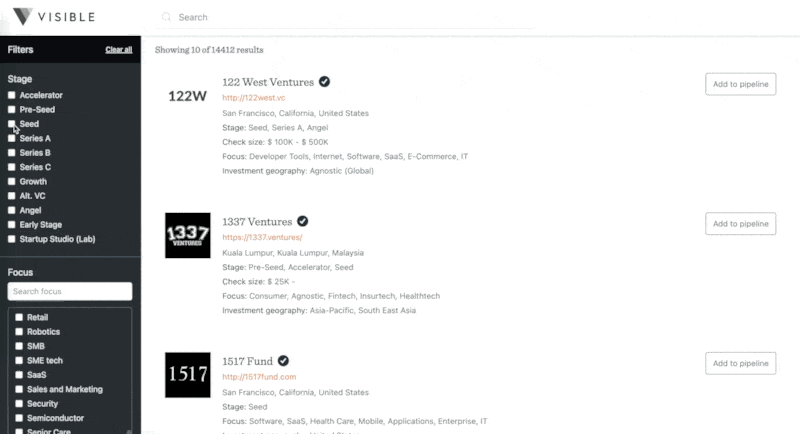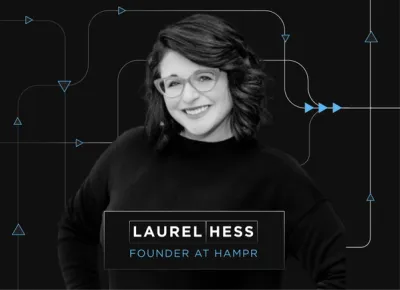
Fundraising is a challenge. We find that the most successful founders treat a fundraise like a traditional B2B sales process. It is a game of relationships and is important that you are connecting with and finding the most qualified investors for your business — just as a sales and marketing team finds the best leads for their product.
Related Resource: 9 Tips for Effective Investor Networking
In order to help you better connect and find the right investors for your business, we’ve put together a quick guide below:
Understanding the Different Types of Investors
First things first, you need to understand who you are talking to. At the highest level, there are different types of investors that are willing to fund privately held companies. From here, you’ll be able to take things a level deeper and identify the specific investor and firms that are best suited for your business.
Related Resource: How To Find Private Investors For Startups

Check out some of our tips for connecting with different types of investors below:
Angel Investors
A common type of startup investor is the angel investor. As we put in our post, How to Effectively Find + Secure Angel Investors for Your Startup, “An angel investor is generally a wealthy individual who is looking to invest spare cash in an alternative investment.” A few tips when it comes to connecting with angel investors:
- Warm introductions — find if anyone in your network can make an introduction
- Social media — some angel investors might have an online presence. Check out Twitter, LinkedIn, etc. to see if there are any in your network
VC Firms
The most common type of startup investor is a venture capital firm. As defined by Investopedia, “A venture capitalist (VC) is a private equity investor that provides capital to companies with high growth potential in exchange for an equity stake.” VCs are professional investors so it is important to have a strategy when finding and pitching them. A few tips below:
- Warm introductions — like angel investors, use your immediate network to find introductions to VCs in your network. Existing investors, other founders, and customers can be great sources of warm introductions
- Cold outreach — If you do not have any connections to a VC fund, you can use cold outreach. To learn more, 3 Tips for Cold Emailing Potential Investors + Outreach Email Template.
- Events — Many VC funds host events dedicated to founders, or attend larger startup events. Leverage these as an opportunity to meet and connect with targeted funds.
Related Resource: Investor Relationship Management 101: How to Manage Your Startups Interactions with Investors
Banks
Traditionally, banks are a source of capital for businesses. With early-stage startups, bank loans have become less common as they are not able to take the risk on early-stage companies. However, for later-stage and proven startups, bank loans can be a strong funding option. A few things to keep in mind:
- Strong performance — your business needs to demonstrate a strong track record and predictability that you can pay back the bank
- Collateral & cash — having high-value collateral and a strong cash position will increase the likelihood that a bank approves your leone.
Alternative Investors
New funding options have taken the startup world by storm over the last few years. Depending on your business and model, some of the newer funding options can be an option. Check out a few of the common options below (from our post, Checking Out Venture Capital Funding Alternatives)
- Pipe — As their website puts it, “Pipe turns MRR into ARR.” So how does it work? Pipe looks at your monthly contracts and offers a cash advance on the annual value of those contracts. In turn, they will take a small % of that contract for offering the cash advance.
- Calm Company Fund — Calm Fund uses their own financing instrument called a Shared Earnings Agreement (SEAL). Essentially, SEALs are geared towards bootstrapped companies that are profitable or approaching profitability.
- Corl — Rather than explaining it ourselves we’ll let the Corl website explain what they do. “Corl uses machine learning to analyze your business and expedite the funding process. No need to wait 3-9 months for approval. Find out if you qualify in 10 minutes.”

6 Helpful Tips for Connecting with Investors
No matter the type of investor, there are common tips and strategies that you can use to connect with investors. Making warm introductions, or connections through people in your network, is typically the best way to get an introduction to an investor. However, attending events, networking with peers, cold outreach, and your current investors are great opportunities. Check out some tips below.
Related resource: How to Get Into Venture Capital: A Beginner’s Guide
1) Use the Right Tools or Platform
Just as sales and marketing teams have dedicated tools for their process, so do founders that are fundraising. By using a tool to find and connect with qualified investors, you’ll set yourself up for success and smoother fundraise.
At Visible, we offer a free investor database, Visible Connect, that allows you to filter by the fields and properties that are most relevant to your business. For example, you can search by their investment geography, stage, market, and more. Give it a try here.

From here, you can add your investors directly to a Fundraising Pipeline in Visible. This is the headquarters of your fundraise and allows you to keep tabs on the status of conversations and pitches throughout your fundraise. Give it a free try for 14 days here.
Related Resource: A Step-By-Step Guide for Building Your Investor Pipeline
2) Target the Right Investors
Spending time on the right investors is a vital part of a successful fundraise. Just as a sales team would only spend time on the most qualified leads, the same is true of a fundraise. By building out a profile of what your ideal investor looks like, you’ll be able to focus on the investors that truly matter to your business.

Learn more about determining your ideal investor profile in our post, Building Your Ideal Investor Persona.

3) Build a List
Once you’ve determined who the right investors are for your business, you need to build a list. Over the course of a fundraise, you will hear countless “Nos” so it is important to have a list of investors to speak with. For an early-stage company, we generally suggest having somewhere around 50 investors to speak with. Brett Brohl of Bread & Butter Ventures recommends talking with at least 60:
4) Tell a Data-Backed Story
At the end of the day, investors want to fund companies that have the ability to turn into huge exits and create returns for them and their LPs. In order to help paint the picture of your potential for growth, you need to use data that helps supplement the story.
When discussing with potential investors, you do not need to go overboard with the data you are sharing. Stick to a metric or 2 from your own business that demonstrates traction. You can even share compelling data from the market that shows why you are set up for success.
Related Resource: How to Model Total Addressable Market (Template Included)
5) Reach Out
Having your assets in place is only half the battle. Having a concise plan and tone for reaching out to potential investors is a must. Generally, finding warm introductions to your ideal investors should be the first line of defense. If you are unable to find warm introductions, don’t be afraid to use cold outreach.
Related Resource: 3 Tips for Cold Emailing Potential Investors + Outreach Email Template
Learn about what Ezra Galston of Starting Line Ventures likes to see in cold outreach below:
As we previously mentioned, chances are you will be talking to 50+ investors over the course of a fundraise. It is important to have a game plan and process in place to track conversations and the status of your raise. With Visible, you can find investors, add them to your pipeline, and track the status of your fundraise all from 1 tool. Give it a free try for 14 days here.
Related Resource: How To Write the Perfect Investor Update (Tips and Templates)
Visible Can Help You Connect With The Right Investors
Fundraising is comparable to a traditional B2B sales and marketing process. Just as any sales process starts by finding the right leads, so should a fundraise. Use Visible Connect, our free investor database, to find the right investors for your business. Give it a try and start searching for investors for your business here.





